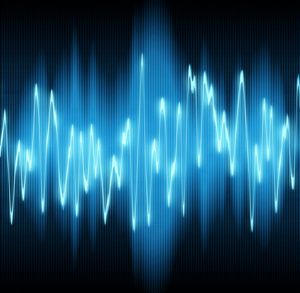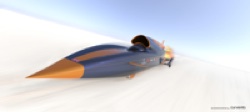A magazine where the digital world meets the real world.
On the web
- Home
- Browse by date
- Browse by topic
- Enter the maze
- Follow our blog
- Follow us on Twitter
- Resources for teachers
- Subscribe
In print
What is cs4fn?
- About us
- Contact us
- Partners
- Privacy and cookies
- Copyright and contributions
- Links to other fun sites
- Complete our questionnaire, give us feedback
Search:
How fast is faster than sound?
The speed of sound is pretty fast. Not the sort of thing any old person could measure in their bedroom is it? Or is it easier than you might think...and why are a team chasing a land speed record interested in your measurements?

Speed is just a measure of how far something travels in a given time: how many metres per second, for example. That means you can calculate how fast something is going just by dividing a distance travelled by the time taken to do it.
Cannon Fire
One way to measure the speed of sound would be to stand a long way from a helper who fires a cannon. You start a stopwatch when you see the cannon flash. Ignoring the time the light takes to get to you, that is the time when the sound sets off. You then stop timing when you hear the bang. Measure the distance in metres you are away from the cannon and divide that distance by the time in seconds you recorded. Easy! You have the speed of sound in metres per second (m/s).
Well sort of. It's a good start and it is the way scientists did do it for a long time, but it isn't going to be very accurate is it? Your reaction time will mess things up a bit for one thing and a stop watch isn't very accurate. Also cannons aren't so easy to come across these days and you would be in big trouble if the cannon ball hit something!
Fastest car on earth
You must need some pretty clever equipment to measure it more accurately mustn't you? Well perhaps not. We were talking to Ian Galloway who is part of the Bloodhound SSC team and he pointed out there is an easy way for anyone to get a really accurate measurement of the speed of sound. The Bloodhound team are building a hi-tech car (Bloodhound) to break the land speed record by 2011. Actually, they intend to completely smash the old record of 763 miles per hour and drive the car at over 1000 miles an hour.

The Bloodhound team are also building a national database of the speed of sound at different temperatures, pressures and humidities, all of which change the speed. They would also like you to contribute by taking measurements for them using Ian's method.
Why are a team working to break the land speed record interested in sound stuff? Well, when you travel as fast as Bloodhound is going to, you push through the sound barrier. That just means that the car will be travelling faster than the speed of sound. Sound is just made by changes of pressure moving through the air in waves, and as you start to go faster than those waves are travelling you generate shock waves.
It is important that the team understand all the science behind what will happen to the car and the air around it as it goes supersonic. For example, shock waves can also do weird things to the car: like make the back end lift...not something that Andy Green, the driver, is very keen to happen. It could turn the car into something closer to a drill that decides to start tunnelling supersonically into the ground! Not good for the driver.
So how can you measure the speed of sound?
First you need some sound recording and editing software. That's easy. Download the free open source Audacity (EXTERNAL) software and install it on your computer. Don't get the "Beta version" but the last fully supported version. You will just need to use it to record sounds so don't worry for now what else you can do with it (though you may want to play later!). You need it to record in stereo, so find the preferences menu (it may be in edit on a PC or under the Audacity menu on a Mac). In the Audio I/O tab go to the recording section and choose "2 (Stereo)" for the Channel. Click Ok and you are set.
Next, place a metre rule on a desk, ideally in the middle of a room with no clutter round to make echoes. You now need some old walkman style headphones. Fasten the two earphone speakers at either end of the ruler exactly a metre apart. Try to be accurate down to a millimetre if you can.
Plug the earphones into the *microphone* socket of a computer. Yes, we did mean the mike socket. A microphone and speakers actually work in the same way and we are going to use the speakers as simple stereo mikes by operating them in reverse. This only works if you don't have fancy new earphones that are clever enough to stop it happening so we've found old, cheap big ones are best.
Now you are ready to do the measurement. Click on the Audacity record (big red circle) button to start the recording. Stand at one end of the ruler and clap your hands once as loud as you can. Stop the recording (yellow square button).
You should have created two sound spikes, one picked up by each microphone. The time between the start of the two spikes is the time the sound took to move the metre between them. Select the area between the first peak on each and you will be given the time between them down at the bottom of the Audacity window. You may
Suppose the time you got was 0:0.003002. That is 0 minutes and 0.003002 seconds. The distance was 1 metre so divide 1 by 0.003002 to give a speed of 331 m/s. We made those numbers up - do the measurements yourself and see what you get. If you can measure the other values of the temperature, air pressure and humidity then the Bloodhound team will want to know your result.
That's science
The combination of coming up with creative new ways to answer apparently difficult questions, then backing them up with careful measurements is one of the things scientists have been doing through history. Welcome to the club!
For more detailed instructions and to find out how to submit your results to the Bloodhound team go to their website.


